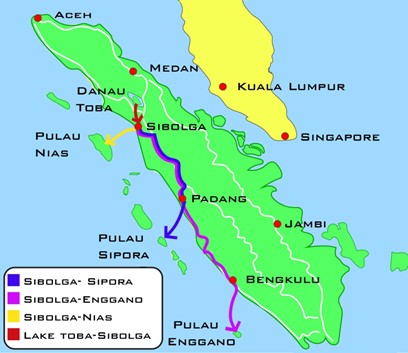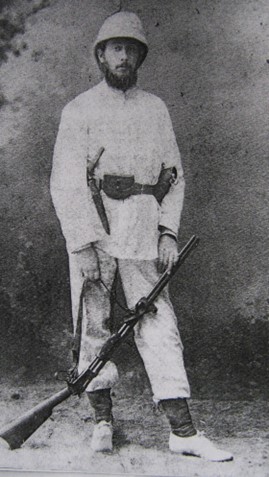Elio Modigliani: an objective observer without any political or economic interests.
In 2014 thanks to the scholarship program offered by my university I spent a semester of study at the University of North Sumatra (Universitas Sumatera Utara, Medan) where I started to study the Batak language, scripts and cultures. In October of the same year, I left for a small excursion to the island of Nias which is one of the few ethnic groups in Indonesia that has preserved its megalithic tradition. I went for a visit to the local ‘Heritage Museum’ (Museum Pusaka) where one of the curators told me Modigliani’s story and showed me his first book, Un Viaggio a Nias (A Trip to Nias).
The story of the Museum’s curator was so fascinating that I felt enticed to further explore the life of this young and almost completely forgotten Italian adventurer. Leaving Europe at the age of twenty-six to go to such remote lands was undoubtedly not easy. It was inconvenient, long, expensive, and also hazardous. Modigliani indeed was travelling around the most dangerous places between 1886 and 1893, areas inhabited by populations that previously had displayed hostility towards foreigners, and that had fiercely resisted any attempt by the Dutch to conquer that region.

Map of Modigliani’s journeys – Giuseppe Ferraioli 2019
Modigliani has left us an extensive written record, meticulously accompanied by images of the collected objects, including not only his research and travel reports in various forms, private letters to his cousin or sister, articles for the Italian Geographical Society, volumes, but also a proceeding of a conference in Rome, which was attended by Queen Margherita of the House of Savoy. Modigliani is a talented author who incorporates with ease matters pertaining to a range of academic subjects, including geography, botany, and zoology — it is estimated that he discovered and described over eight hundred new species! — history, and language.
His writing is not purely academic but he also shows his own emotional involvement and empathy for the local population. However, and despite the fact that his travel reports are important ethnographic studies, and also one of the few studies on Indonesian cultures ever conducted in Italian, Modigliani’s work has received little attention, probably due to his Jewish origins which were an obstacle to the dissemination of his knowledge during the fascist period.
Given the extent of his written records, I have decided to divide this exploration of Modigliani’s life and travels into four parts to be able to not only restore the coordinates of Modigliani’s travels but also to give space to those human and personal qualities that are widely imbued to his stories of travel. The first section, which is the present one, aims to portray this forgotten Italian life and scientific background. The remaining 3, will each be dedicated to one of his trips to Indonesia (Nias, Batak, and Enggano), through reading and commenting on his travel diaries. Enjoy the journey.
Elio Modigliani: life and education

Elio Modigliani in Nias [Public domain]
After his graduation from the University of Pisa in 1883, Modigliani dedicated himself to scientific training and preliminary research for a possible expedition to Southeast Asia. He spent this crucial period of training between Florence and Genoa, where the most advanced scientific research centres during Italy’s post-unification era were located. Here he studied the most accurate survey methodology. In Genoa, he studied at the laboratories of the Civic Museum of Natural History founded by Doria where he learned the techniques of conservation of naturalistic specimens, and at the Hydrographic Institute of Genoa’s Marina. He also learned to use sextant and topographic surveying practices.
Under the guidance of Mantegazza and Enrico Hillyer Giglioli in Florence, Modigliani studied anthropological and ethnographical research methods: from anthropometric surveys and the study of costumes, to photographic documentation of places and people. He then went to Europe to study at a number of research institutions. In the Netherlands, he studied the Malay language and became acquainted with the most recent scholarly literature about the Indonesian-Malay archipelago. The theoretical framework in which Modigliani’s activities were embedded is fundamental to understanding the value of his work.
The late nineteenth century was a period of significant changes for Italy: those were the first years of the unified state, and the beginning of the era of Italian imperialism during which parts of Africa were colonised. The human sciences in this period were firmly and deeply imbued, in their institutional and theoretical growth, with positivistic and evolutionist theories. One of the main objectives was the conservation and documentation of the past, seeking and finding in the so-called savage societies surviving remnants of the history of humanity. The destinations for this sort of investigation were the hitherto unexplored lands, unknown, and inhabited by tribal populations. Moreover, the demands of colonialism ‘to know to be able to rule and to control’, led to an intensified research oriented towards the observation of peoples and their study based on empirical evidence (Puccini 1999: 183-218).
Modigliani does not show the usual attitude of his time where travellers and colonial officers tend to describe the objects of their studies in demeaning terms. Modigliani distinguishes himself from his contemporary observers: he systematically prepares himself for his journey; he conducts field research over a sufficiently long time involving a combination of participant observation and artefact analysis. Furthermore, Modigliani is an objective observer without any political or economic interests. Financially too, he is completely independent as he financed his journey himself. From an ideological point of view, Modigliani is also different in that he is not influenced by imperialistic, racist, or colonial ideologies, and in his travel reports, he often sides with the ‘natives’ and openly criticises the cruelty and inadequacies of the Dutch colonial regime.
His first trip was to the island of Nias, from 1886 to 1890. Afterwards, in the autumn of 1890, Modigliani left for the independent lands of the Bataks in North Sumatra. In 1891, forced by the Dutch authorities, he decided to leave for the island of Enggano — a small island located on the southern part of the west coast of Sumatra — which was almost completely unknown in Modigliani’s time. He ultimately decided to reach the Mentawai archipelago, but it seems that the critical attitude of the local population and the serious infection he contracted made the mission shorter than planned and forced him to return to Italy early. After the failure of this expedition, Modigliani was never able to venture into those remote lands again.
Upon his return to Italy from his last expedition, Modigliani moved permanently to Florence and devoted himself to organising his collections to be donated to the National Museum of Anthropology and spent the last years of his life writing recollections of his travels. When she died at the age of 72, on the sixth of August 1932, her daughter Mohua was less than 10 years old. She is still alive; her name means ‘perfumed’ in the Nias language, a term used only in sweet love exchanges.
References:
Chiarelli (2002), Elio Modigliani, viaggiatore e naturalista sulla rotta delle meraviglie Nias, Sumatra, Engano, Mentawei (1886-1894): lo sguardo, il racconto, la collezione, Firenze
Puccini (1988), ‘Elio Modigliani. Esplorare, osservare, raccogliere nell’esperienza di un etnografo dell’Ottocento’, La Ricerca Folklorica, pp. 25-40, Rome.
Puccini (1999), Andare lontano: viaggi ed etnografia nel secondo Ottocento, Vol. 63, Carocci, Rome.

Giusy Monaco is a researcher, language teacher and translator. She has a PhD in Indonesian Studies, with a Philology specialisation, at the Università degli studi di Napoli “L’Orientale”.
She is currently teaching an online Italian language course for the University of Diponegoro, Indonesia.
